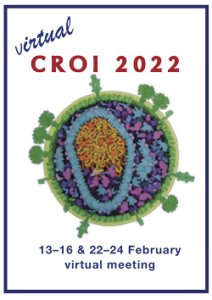CROI 2022: Higher maternal mortality and adverse birth outcomes among women with COVID-19 in Botswana
1 March 2022. Related: Conference reports, Women's health, Pregnancy, CROI 29 (Retrovirus) 2022.
 Polly Clayden, HIV i-Base
Polly Clayden, HIV i-Base
Maternal mortality was higher among women with COVID-19 compared to those without in the Tsepamo Study, and infants born to women with COVID-19 had increased risk of adverse birth outcomes.
Maternal deaths did not differ by HIV status but infants exposed to both COVID-19 and HIV were at the highest risk for most adverse outcomes.
These data from Botswana were presented at virtual CROI 2022.
Botswana has a high prevalence of women living with HIV and, like most countries, experienced a COVID-19 epidemic in 2021. The Tsepamo Study performs birth outcomes surveillance at government hospitals countrywide.
Both COVID-19 and HIV can lead to adverse birth outcomes. But there are limited data describing the combined effect. This study looked at adverse birth outcomes among women routinely tested for COVID-19 by HIV status. Notably it was conducted during a period when few women had access to COVID-19 vaccination in Botswana.
The investigators analysed data from 13 Tsepamo sites that performed routine COVID-19 screening at delivery with rapid antigen or PCR testing between 1 September 2020 and 15 November 2021. This period included Beta and Delta variants but not Omicron.
Singleton deliveries with known HIV status and a COVID-19 screening test 14 days before and three days after delivery were evaluated.
Adverse outcomes included maternal death, preterm delivery, very preterm delivery, small for gestational age, very small for gestational age, stillbirth, and neonatal death.
There were 20,410 deliveries during the study period (44% without a COVID-19 test); 11,483 were screened for COVID-19 and 539 (4.7%) were positive. Of these, 144 (5.6%) were among women living with HIV and 392 (4.3%) among HIV negative women. Women with HIV were more likely to be COVID-19 positive at delivery (p<0.01).
Maternal deaths were high with COVID-19, particularly during Delta, but did not differ by HIV status.
Overall, there were 19 (4%) vs 12 (0.1%) deaths among women with and without COVID-19, respectively. Age adjusted risk ratio (aRR) 31.6 (95% CI 15.4 to 64.7).
Among women living with HIV, for those with and without COVID-19, there were: 4 (3%) vs 3 (0.1%) deaths respectively; aRR 23.3 (95% CI 5.3 to 102.8). The respective values for HIV negative women were: 15 (5%) vs 5 (0.1%); aRR 35.6 (95% CI 15.7 to 81.0). Of note ART use is very high in this cohort: 97% of women with HIV receiving ART of which over 75% started before conception.
By variant, pre-Delta and during Delta with and without COVID-19, maternal deaths were respectively: 3 (2%) vs 5 (0.1%); aRR 13.9 (95% CI 3.4 to 57.2) and 15 (5%) vs 5 (0.1%); aRR 56.3 (95% CI 20.5 to 154.7).
Adverse birth outcomes were higher among infants born to women with COVID-19 (n=539) compared with those without (n=10,944): 185 (34.5%) vs 2899 (26.6%); aRR 1.31 (95% CI 1.16 to 1.48).
These were elevated across all adverse outcomes among infants born to women with COVID-19 and most notable for still birth: 30 (5.6%) vs 297 (2.7%); aRR 1.97 (95% CI 1.37 to 2.84).
Adverse birth outcomes were highest among infants born to women with COVID-19 and HIV (n=144) compared to HIV only (n=2277): 62 (43.1%) vs 692 (30.4%); aRR 1.78 (95% CI 1.47 to 2.16).
The investigators concluded that maternal mortality was higher in women who were COVID-19 positive – with nearly 4% maternal mortality, giving a 30-fold increase compared with those women without COVID-19 at delivery.
Infants born to COVID-19 positive women had more adverse birth outcomes, including a 5.5% risk of still birth – a 2-fold increase.
Infants born to women with COVID-19 and HIV had the highest risk for adverse birth outcomes.
comment
Presenting author, Maya Jackson-Gibson, highlighted three limitations to this study:
- It was not possible to evaluate the effect of vaccination as this was not documented in maternal obstetric cards, but vaccination was limited in Botswana during the study period (only less than 15% fully vaccinated by late 2021).
- If the availability of test kits was limited, symptomatic women might have been preferably screened.
- Omicron variant only became dominant in Botswana in December 2021 – after the study period.
Numbers in the maternal mortality subgroup analyses were also notably small with wide confidence intervals, but the overall effect is concerning and hopefully will improve as the vaccination programme matures in Botswana.
Tsepamo is continuing to look at the effect of COVID-19 on maternal mortality and infant outcomes and this next period of surveillance includes the Omicron variant.
References
Jackson-Gibson M et al. The impact of COVID-19 on adverse birth outcomes in Botswana by HIV status. CROI 2022, 12–16 and 22–24 February, virtual meeting. Oral abstract 29.
https://www.croiconference.org/abstract/the-impact-of-covid-19-on-adverse-birth-outcomes-in-botswana-by-hiv-status/
This report was first posted on 15 February 2022.

